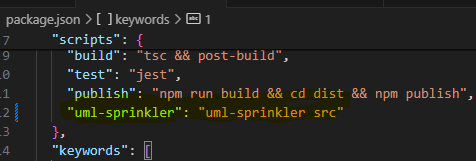This is a project that converts TypeScript to UML.
This project, ts2uml, is designed to convert TypeScript code into UML diagrams.
This script is designed to read TypeScript files from a given directory (including subdirectories) and add a @uml() decorator to any classes that don't already have it. The directory path is provided as a command-line argument.
Executing uml-sprinkler is optional if you choose to do manually annotate the methods and classes.
- Apply the sequence decorator to your class or methods:
/**
* class declaration annotated
class MyClass {
@uml()
public myMethod() {
// Method implementation
}
}
// start the sequence by setting the request id for workflow
setTraceId("R12"); // can be random, unique and retrievable
// Start of the sequence
let l1=new MyClass();
l1.myMethod();
// End of the sequence
console.log(getSequence());
console.log(getSequenceTemplate());
console.log(getFlowDiagram());
/**
* getSequence returns the text uml
*
* output will be like
* sequenceDiagram
* R12->MyClass:myMethod
*
*/
- The sequence decorator will modify the original method to apply a graph sequence. It creates a new GraphNode if one does not already exist for the requestId, applies the graph sequence, and handles any errors that occur during the execution of the original method.
setTraceId is a function used to assign an unique identifier (the sequence ID, which is the same as the request ID in this case) to each request. This is done for tracking, logging, or handling each request in your sequence diagram.
In AWS, the RequestId is a unique identifier assigned to each request that the service receives. This ID is used to track the request through the system and to identify the request in logs and other diagnostic information. In the context of the sequence diagram, the sequence ID is similar to the RequestId in AWS, as it is used to identify and track each request through the system.
The request ID can be assigned to the sequence ID and can be used in the AWS context to track and identify each request in a sequence diagram. You can easily identify and track the flow of requests through the sequence diagram. This can be useful for debugging, monitoring, and analyzing the performance of your system.
the workspace folder will contain a folder after successful execution which contains the diagram from your code


